I have a delete function for my table which is a delegate of a fetch controller. When i swipe delete a row it clears the object and deletes its data, but the cell persists as an empty row.
My fetch and table code looks like this, any idea why it doesnt delete the row too?:
func controller(_ controller: NSFetchedResultsController<NSFetchRequestResult>, didChange anObject: Any, at indexPath: IndexPath?, for type: NSFetchedResultsChangeType, newIndexPath: IndexPath?) {
switch (type) {
case .update:
if let indexPath = indexPath, let cell = workoutDesignerTable.cellForRow(at: indexPath) as? RoutineTableViewCell {
configure(cell, at: indexPath)
}
break;
default:
print("...")
}
}
}
func tableView(_ tableView: UITableView, editActionsForRowAt indexPath: IndexPath) -> [UITableViewRowAction]? {
let delete = UITableViewRowAction(style: .destructive, title: "Delete") { (action, indexPath) in
let UserExercise = self.fetchedResultsController.managedObjectContext
UserExercise.delete(self.fetchedResultsController.object(at: indexPath))
do {
try UserExercise.save()
} catch {
let nserror = error as NSError
fatalError("Unresolved error \(nserror), \(nserror.userInfo)")
}
self.workoutDesignerTable.reloadData()
}
let edit = UITableViewRowAction(style: .normal, title: "Edit") { (action, indexPath) in
let cell = tableView.cellForRow(at: indexPath)
self.updateExercise = self.fetchedResultsController.object(at: indexPath)
self.performSegue(withIdentifier: self.segueEditUserExerciseViewController, sender: cell)
}
edit.backgroundColor = UIColor.lightGray
return [delete, edit]
}
Pics of the issue below:
I have added the following func which hasn't resolved the issue
func tableView(_ tableView: UITableView, commit editingStyle: UITableViewCellEditingStyle, forRowAt indexPath: IndexPath) {
if editingStyle == .delete {
let UserExercise = fetchedResultsController.managedObjectContext
UserExercise.delete(fetchedResultsController.object(at: indexPath))
do {
try UserExercise.save()
} catch {
let nserror = error as NSError
fatalError("Unresolved error \(nserror), \(nserror.userInfo)")
}
}
tableView.deleteRows(at: [indexPath], with: .fade)
}
also here is the numberOfRowsInSection as requested
func tableView(_ tableView: UITableView, numberOfRowsInSection section: Int) -> Int {
guard let userExercises = fetchedResultsController.fetchedObjects else { return 0 }
return userExercises.count
}
I have added the above console print to show after deleting the print of the object which seems to read as having a fault if this helps narrow it down
added the fetchresultscontroller code below
fileprivate lazy var fetchedResultsController: NSFetchedResultsController<UserExercise> = {
let fetchRequest: NSFetchRequest<UserExercise> = UserExercise.fetchRequest()
if self.userRoutine == nil {
fetchRequest.predicate = NSPredicate(format: "usersroutine == nil")
} else if self.userRoutine != nil {
fetchRequest.predicate = NSPredicate(format: "usersroutine.name == %@", self.userRoutine!)
}
fetchRequest.sortDescriptors = [NSSortDescriptor(key: "dateCreated", ascending: true)]
//controller config
let fetchedResultsController = NSFetchedResultsController(fetchRequest: fetchRequest, managedObjectContext: self.persistentContainer.viewContext, sectionNameKeyPath: nil, cacheName: nil)
fetchedResultsController.delegate = self
return fetchedResultsController
}()
Additional Controller Delegate Code:
func controllerWillChangeContent(_ controller: NSFetchedResultsController<NSFetchRequestResult>) {
workoutDesignerTable.beginUpdates()
}
func controllerDidChangeContent(_ controller: NSFetchedResultsController<NSFetchRequestResult>) {
workoutDesignerTable.endUpdates()
updateView()
}
// MARK: - ADDING TABLE ROW AND EDITORIAL FEATURES
func controller(_ controller: NSFetchedResultsController<NSFetchRequestResult>, didChange anObject: Any, at indexPath: IndexPath?, for type: NSFetchedResultsChangeType, newIndexPath: IndexPath?) {
switch (type) {
case .update:
if let indexPath = indexPath, let cell = workoutDesignerTable.cellForRow(at: indexPath) as? RoutineTableViewCell {
configure(cell, at: indexPath)
}
break;
default:
print("...")
}
}
}



